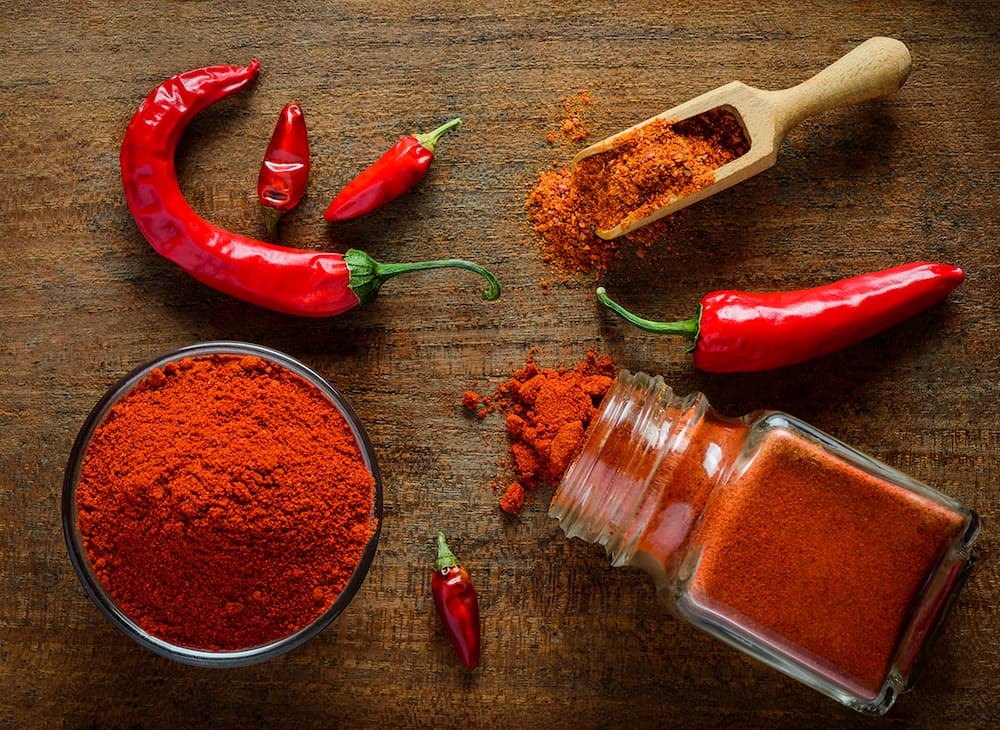
The Pepper (Capsicum) belongs to the Solanaceae family and originates from South America from where, through Columbus, it reached Spain and its cultivation began. Initially, the monks were the ones who began to introduce it in monasteries such as those of La Ñora (Murcia) and Yuste (Cáceres), after which it was cultivated more widely among the people. The drying and subsequent grinding of the peppers results in paprika. There are different species of Capsicum which produce paprika. The most common species are annuum, chinense, frutescens and pubescens, although there are many more.
Paprika as an ingredient in the food industry
Sweet, hot or smoked paprika is a universal condiment used in all kinds of sauces and seasonings to add colour and flavour to spice mixtures. Sauces and condiments are used in all kinds of seasonings for meat, fish, pasta and pizza. Some examples of sauces in which paprika is used are Barbacoa, Brava or Enchilada sauces.
Paprika is also widely used in different dishes, such as Rioja-style potatoes, Galician-style octopus, hummus or goulash, and in sausages, such as chorizo and sobrassada sausages.
Types of paprika
Sweet paprika is a condiment made from specific varieties of dried paprika. The grinding process can be done by removing all the seeds of the pepper, or by adding more seeds. This allows the production of different qualities of paprika, ranging from 40 to 180 ASTA.
Hot paprika
Hot paprika is obtained from different varieties of peppers, other than sweet peppers, and can have different intensities of spiciness depending on which variety is used, as they have a different capsaicin content; this is the substance that gives paprika its spicy flavour. Pungency can be measured in Scoville heat units (SHU), which is an organoleptic scale of measurement and is therefore imprecise, or in ppm, quantifying the content by chromatography. The ratio between these two scales is 15:1; 15 SHU equals 1 ppm.
Smoked paprika
Smoked paprika is made from sweet varieties, which may be the same or different from those used for sweet paprika, and which during the drying process in vertical current dryers are subjected to smoke from holm oak, oak and aromatic shrubs. This drying process, which can take up to two weeks, gives the paprika its unique aroma and flavour.
Paprika is commercially classified by ASTA grades, which is a measure of the colouring power of paprika. In general, the higher the ASTA, the better the quality.
In terms of packaging, we can manufacture either under our own brand name, Fenix Spices, or under the customer’s brand name, in a variety of formats:
Big-bags from 500 Kg to 1,000 Kg.
25 kg raffia sacks with PE liner.
25 kg paper sacks with PE liner.
25 kg PE sacks with PE liner or with barrier film liner, which allows us to pack in a protective environment, delaying the natural oxidation process of the carotenoids in paprika.
10 Kg cans.
10 and 5 Kg raffia or aluminised sacks.
Jars from 50g to 1,000g.
Paprika flakes and seeds
We offer paprika by-products such as flakes and seeds.

Flakes comes from dehydrated and dehulled peppers that are crushed and sieved until the desired size is obtained. They can be of 1-2 mm, 3-5 mm, as well as other sizes
Paprika seeds

Seeds are obtained by separating them from the rest of the pepper using sieves.
The flakes and seeds can be sweet or hot and either with or without heat treatment to reduce the bacterial load.
The packaging of the flakes and seeds can be done under our own brand name, Fenix Spices, or under the customer’s brand name, in a variety of formats:
Big-bags from 500 Kg to 1,000 Kg.
20 or 25 kg raffia sacks with PE liner.
20 or 25 kg paper sacks with PE liner.
25 kg PE sacks with PE liner.
10 and 5 kg raffia or aluminised sacks.


